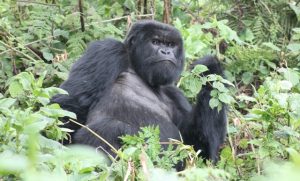
Is it safe? This is the first question anyone will ask before joining in any adventure activity. Gorilla trekking in Rwanda is one of the most captivating wildlife adventures in the world. The thought of trekking dense pristine jungles on beautiful mountain volcanoes and coming face to face with these massive apes without a barrier in between is quite thrilling but also thought provoking – how safe is it?
Is it safe for me?
Won’t the gorillas attack me? Won’t I encounter other dangerous creatures in the jungles? Rwanda neighbors the ever security volatile Democratic Republic Congo, what are the chances of falling victim to this insecurity from the neighborhood (especially that Volcanoes National Park in Rwanda is connected to the Virunga National Park in DR Congo which is a hotbed of rebel activity)? Etc…
These are some of the concerns & questions of many travelers when thinking of booking a gorilla trekking trip to Rwanda.
I will address the above concerns below and give some assurances;
The gorillas are wild animals, won’t they attack me?
Gorillas, like other wild animals, their instinct is to attack or flee when they encounter an unfamiliar creature in their environment. Gorillas are the biggest primates, the strongest as well whose strength is said to be equivalent to about 8 grown healthy energetic human males. So they would rip apart or break a human with such ease…
However the gorillas you track in Rwanda are habituated. Habituation is the process of getting the gorillas used to seeing humans in their environment until they realize the humans mean no harm & will therefore not attack or flee. Gorilla habituation is done by trained personnel & habituating one gorilla family until its safe for tracking takes more than 3 years. The habituated gorillas can tolerate the humans who are observing gorilla trekking SOPs for some time. They are world animals and there are certain guidelines you have to observe when in their presence so that they feel safe. These guidelines are provided before setting out to trek.
What about encountering other dangerous creatures in the jungles?
True there other animals in Volcanoes National Park that could pose a threat to you while trekking, and these include; unhabituated gorillas, elephants, buffaloes, etc.. Elephants, buffaloes, are very few and quite shy. They mostly flee before they are sighted and most times you will see just their foot prints & dung. However, an encounter cannot be ruled out completely. So safety, on your trek you do go with armed personnel whose purpose is to shoot in the air to scare away buffaloes, elephants or even unhabituated gorillas who may try to face off with the travelers. These encounters are rare but they few times they happen the armed personnel are always on top of things.
Snakes also come into mind when one thinks of trekking in the jungles. Due the high altitude and cold temperature the Volcanoes are not favorable for many snake species. There are few snakes but these are very hard to come by. They are very shy and will flee immediately detecting an intruder many yards away.
How is the security situation in the Volcanoes National Park and shouldn’t I be concerned about the volatile security situation in the neighboring Congo and the Virunga Park?
Rwanda is one of the safest and most security conscious country in Africa, perhaps even in the entire world. Given her unpleasant past of turmoil, the country takes security and safety of every individual in the country as number one priority. The park is well protected by the armed forces, and besides most of the gorilla trekking takes place well away from the boundaries. An intrusion from the Congo side is almost impossible to go undetected.
Is it safe for the gorillas?
This is a very valid concern!!
The biggest threat gorillas face from humans is the possibility of transferring human disease to the gorillas. Gorillas and humans share up to 98% DNA hence diseases can be transferred between the two species. To prevent you from spreading diseases to gorillas, once you show any symptoms for easily transferrable diseases such as cough, flue you are not allowed to track the gorillas. During the encounter with the gorillas, tourists are advised to keep at least 7 meters from the gorillas.